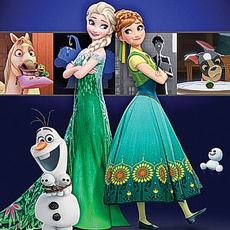
By Steven Clark, Rebecca Cline
Disney Editions
September 7 2016
Hardcover with 160 illustrated and photograph-heavy pages
$60
Following the huge media hoopla surrounding the return of Walt Disney’s original cartoon star, Oswald The Lucky Rabbit, to the Disney Studio, it seems the company has eschewed various opportunities to showcase its amazingly storied history. Yes, there are ongoing efforts to preserve and restore a wealth of material across many different media, but with the demise of the Walt Disney Treasures line of rare and vintage shorts, television episodes and features on DVD, it has become harder and harder for long-time Studio fans to actually collect the films that made us love all things Disney in the first place.
With a handful of important titles – including Walt’s 1940s Package Features – still to make it to Blu-ray Disc and an almost total lack of the company’s legendary short subjects available on the format, it’s somewhat fallen to the company’s publishing division to fill the gap for the Disney collector, particularly in the formation of the popular D23 fan club and its various special events, while the Studio’s only mining of its back catalog these days is to cherry pick properties ripe for a remaking, from the early 1940s features (Tim Burton’s in-development Dumbo) to the films of the 1990s renaissance (the upcoming Beauty And The Beast and an Aladdin spin-off).
 In lieu of this, and consistently serving up the goods, is the Disney Books Group, by way of their own Disney Editions imprint and licensing arrangements with the likes of Chronicle, Insight and Titan, publishers of various Art Of… volumes and various retrospectives on the Studio’s films, artists and history, including everything from individual theme-park attractions to Walt himself and his philosophies.
In lieu of this, and consistently serving up the goods, is the Disney Books Group, by way of their own Disney Editions imprint and licensing arrangements with the likes of Chronicle, Insight and Titan, publishers of various Art Of… volumes and various retrospectives on the Studio’s films, artists and history, including everything from individual theme-park attractions to Walt himself and his philosophies.
Over the past few years, and picking up where the supplemental extras and still-frame galleries on the home video discs of old left off, there’s been something of an explosion in such books that delve into the creative process of the classic Disney animated features, and in particular those that showcase previously unseen concept art for these films.
A few of these books focus exclusively on these artworks, but there’s never, to my knowledge, been a book quite like The Walt Disney Studios: A Lot To Remember, which focuses not on the films or filmmakers behind them, but on the actual buildings, rooms and spaces where those films were actually made. For even the most ardent Disney fan, especially those that have collected enough books to have started to come across the same art two, three or more times across various titles, this is a fascinatingly unique angle to take, and one that promises a completely fresh approach to the Disney story.
Of course, the term Walt Disney Studios applies to wherever Walt was based and was making his films and, although this book quite rightly focuses on the historic lot still to be found to this day at 500 South Buena Vista Street in Burbank, it does not ignore the earlier years, with a brief but perfectly informative opening chapter on Walt’s initial Kansas City digs in various garages and shops, and the original Disney Bros. Studio in Hollywood, to Walt Disney Productions’ first home at the historic Hyperion Studios and the golden age of the Mickey Mouse and Silly Symphony shorts that led to the creation of the game-changing Snow White And The Seven Dwarfs (wonderfully documented in detail on the original Diamond Edition Blu-ray of the film).
 Of particular interest amongst the number of photographs from this era are drawings of two of the main buildings, on Kingswell Avenue and Hyperion, that give a detailed approximation of how the Disney Studios of the time were laid out, revealing the Kingswell address’ restroom doubling as a dark room! (Later, in a similar fashion at the tail-end of the book, site plans for successive decades show how today’s lot has changed.)
Of particular interest amongst the number of photographs from this era are drawings of two of the main buildings, on Kingswell Avenue and Hyperion, that give a detailed approximation of how the Disney Studios of the time were laid out, revealing the Kingswell address’ restroom doubling as a dark room! (Later, in a similar fashion at the tail-end of the book, site plans for successive decades show how today’s lot has changed.)
And what is seriously impressive is the reminder of just how fast Walt, his team and his Studio needed to expand, and how quick the company grew, thanks to the success of the Alice Comedies and subsequent shorts. With the arrival of animated feature film making, space was in short supply at Hyperion by this time, but luckily cash wasn’t, thanks to the huge popularity of Snow White. Ever looking to the future, Walt knew he needed (another) new location, and one that could continue to expand in a planned method, unlike the topsy-turvy way the various expansions at Hyperion had occurred.
This is where A Lot To Remember kicks into high gear, detailing intricately the initial concepts of the eventual Studio’s campus approach and attempts to keep its staffers fit and happy, as well as shining a spotlight on a handful of instrumental names, including Kem Weber, who hardcore fans will remember as the overall architect of the site and whose work was detailed in an excellent Walt Disney Treasures compendium on the Disney Studios (if there’s one slight disappointment in this book, it’s that we don’t see more of Weber’s sleek and sharp designs, perhaps a valid basis for a volume of its own?).
The book progresses into a “tour” of the then-new facility, which pretty much became a victim of its own success as soon as it opened, from the expanded scope and less direct access to Walt resulting in a loss of camaraderie between the artists that led to the cartoonists’ strikes of 1941, to the outbreak of World War II and the requisitioning of the Studio by the US Army. These were dark days for the Disneys, with the war effort not only swamping the new site but influencing Walt’s films as well. Donald Duck was drafted, and Walt managed to stay afloat by turning out propaganda, training films and compilations, known as Package Features, which were largely made up of the kinds of shorts that had replaced the now-ended Silly Symphonies.
As current director of the Walt Disney Archives, author Becky Cline is well-placed to guide us through these facts and photos while her co-writer Steven Clark has worked in countless areas of the company, most notably in publicity for the Disneyland and Feature Animation units, but also at the Archives as an author with the legendary Dave Smith and, significantly, founding the D23 fan club, where much of this kind of information is often shared through its close ties with the Archives. The big attraction here, of course, are the images but where the book really scores is in the authors’ context, giving us just enough detail and depth without going over the well-worn stories of Walt’s betrayal by Charles Mintz and subsequent creation of Mickey, or too much about the making of certain films when they have been covered elsewhere.
 The book also takes something of a chronological approach, too, so that as the Studio expands, so the timeline proceeds, from the Package Features of the later 1940s to the return of full-length films Cinderella, Alice In Wonderland and Peter Pan (all of which made use of the soundstages to photograph live-action reference footage) in the early ’50s, just as live-action features and television transformed the Studio again.
The book also takes something of a chronological approach, too, so that as the Studio expands, so the timeline proceeds, from the Package Features of the later 1940s to the return of full-length films Cinderella, Alice In Wonderland and Peter Pan (all of which made use of the soundstages to photograph live-action reference footage) in the early ’50s, just as live-action features and television transformed the Studio again.
Here, the likes of 20,000 Leagues Under The Sea, Davy Crockett, Zorro and Mary Poppins take over, with spots to mention the nearby Golden Oak Ranch filming location and a good portion devoted to the technological achievements to come from the Studio, mostly focusing on the formation of WED Enterprises and its developments for Disneyland.
The later, creatively leaner years are a little more sketchily drawn – although it’s always fun to see the Studio used as the Medfield College campus in the Dexter Riley comedies of the ’70s – before the coming of Michael Eisner signalled a revitalisation to both the newly named Walt Disney Company and the soon to expand again Studio (though it is decent that the birth of Touchstone Pictures is attributed to the Ron Miller years, even if one has to read between the lines to note it). Eisner’s regime ushered in the animation revival, of course, as well as the most recent Studio landmark in the Team Disney building, its roof held aloft by the Seven Dwarfs.
While this is something of an ironic dedication for a film that wasn’t made on this lot, it was the film that made it obvious Walt needed a bigger sandpit and provided the means to do it, so there is something to be said for having Disney’s headquarters resting on the shoulders of these giants, the statues almost literally being the foundations for the Studio that was built upon the success of Snow White. Mickey’s sorcerer hat Animation Building followed soon after, as did new CEO Bob Iger and the acquisitions of Pixar, Marvel and Lucasfilm that brings the book up to date with mentions of the Pirates Of The Caribbean series and Saving Mr Banks, the latter of which, of course, filmed extensively in, and provided a fine showcase for, the recreated Disney Studio lot as it once was.
Somewhat mid-way between The Walt Disney Company’s recent 90th birthday and a centennial celebration on the horizon, The Walt Disney Studios: A Lot To Remember serves as an excellent and heartfelt tribute to the iconic location where the majority of our favorite Disney movies were developed and created. Never was there a plant, as Walt and his artists used to call it, like the Disney Studio in its heyday, and trawling through this book’s many delights, both in the bright text and phenomenal gallery of images, is a perfect reminder of the place itself. The reputation of the films themselves goes without saying, and we often remember the various artists and technicians that continue to emerge from Walt’s shadow and those that are still adding to that story with stories of their own today. But this is where they all worked, and never has there been a finer and more appropriately compiled volume on the subject than this book. Hghly recommended!

is available to buy now from Amazon.com





